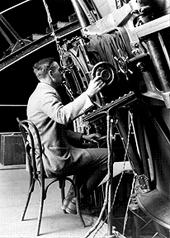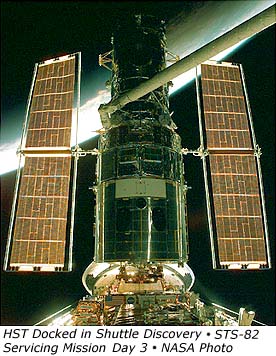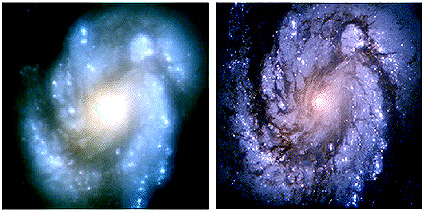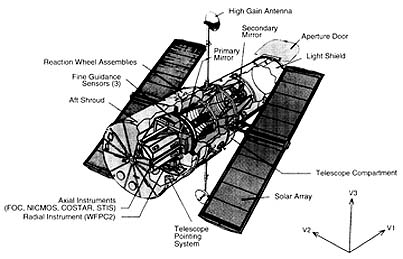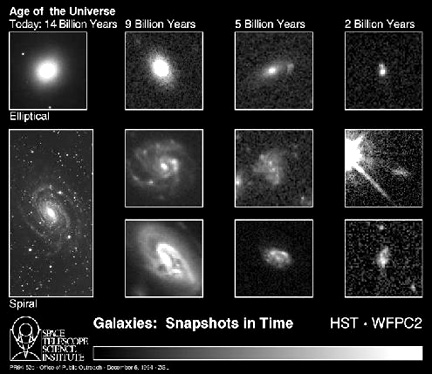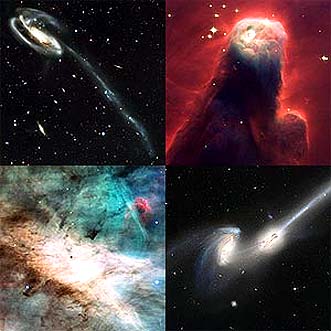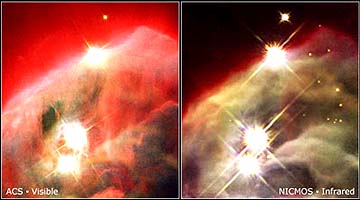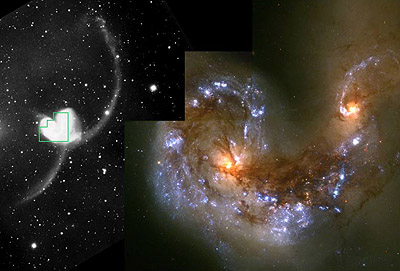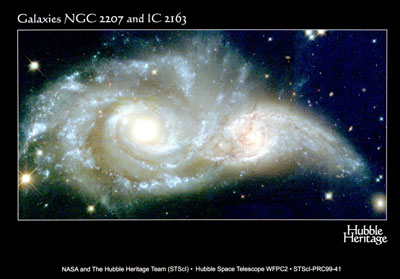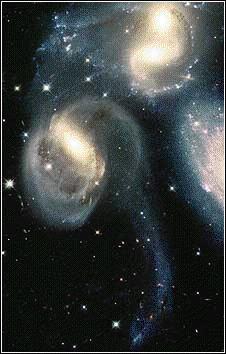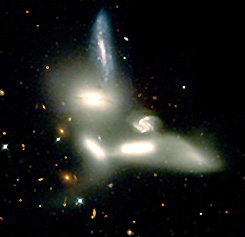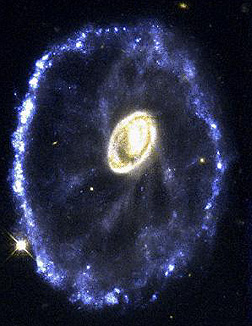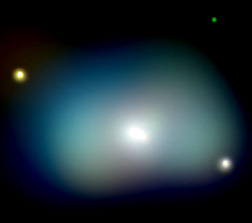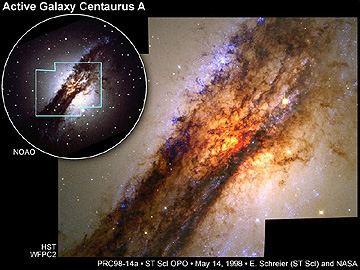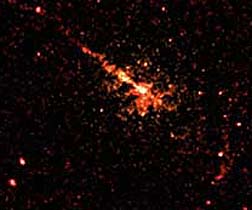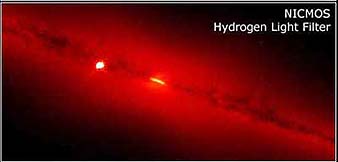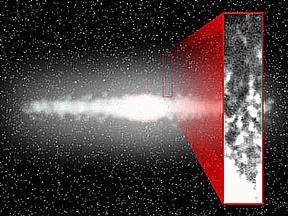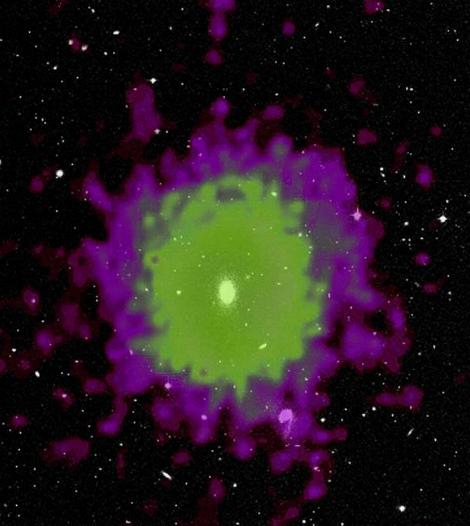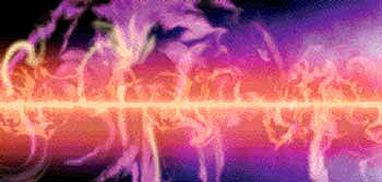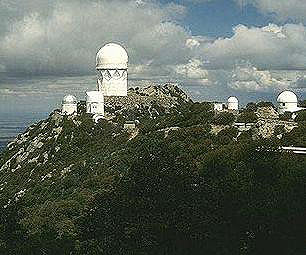
Even when placed away from
cities and on high mountains, the effects of the atmosphere, smog, any nearby
lights, etc. degraded these images. As the space programs developed, astronomers
dreamed of placing the telescopes in space orbit where viewing conditions were
optimized.
A "giant leap" in optical
imaging is embodied by the Hubble Space Telescope (HST). This, the finest telescope
up to the present and (in the writer's opinion) the greatest accomplishment of
NASA so far) receives its name to honor Edwin Hubble, the man who confirmed much
about the existence, distribution, and movement of galaxies, leading to the realization
of an expanding Universe. Here he is at work in the 1920s on the 100-inch Palomar
telescope:
Perhaps no other
astronomical observatory has captured the public's imagination, with its numerous
sensational pictures, than has the Hubble. HST has provided many extraordinary
views of galaxies, dust clouds, exploding stars, et. al., extending throughout
the Universe. Many scientists contend that this is the most remarkable scientific
tool ever put into space. HST is the outgrowth of a concept first suggested
in 1946 by Lyman Spitzer who argued that any telescope placed above Earth's
atmosphere would produce significantly better imagery from outer space. Launched
in April of 1990 after 20 years of dedicated efforts by more than 10000 scientists
and engineers, HST proved unable to deliver quite the sharp pictures expected
because of a fundamental mistake in grinding the shape of its primary (2.4 m)
mirror. The curvature was off by less than 100th of a millimeter but this error
prevented focusing of light to yield sharp images. In December of 1993 the
Hubble was revisited by the Space Shuttle, as shown in this close-up view. At
that time 5 spacewalks succeeded in installing corrective mirrors and servicing
other sensors. A second Shuttle mission in February, 1997 was also successful
in upgrading the equipment. A third servicing took place in late December, 1999
and a fourth in March of 2002 (see below).
After the first servicing
mission, the striking improvement in optical and electronic response is evident
in the pair of images below made by the telescope, which show the famed M100 (M
denotes the Messier Catalog number) galaxy viewed by the Wide Field Planetary
Camera before and after (right) the correction.
A general description of
the Hubble Space Telescope and its mission is given in this review. Information on
both original instruments and those added later appears in this site prepared
by Space
Telescope Science Institute. This cutaway diagram shows the major features
and components of the HST:
Many of the most informative
HST images can be viewed on the Space Telescope Science Institute's (Baltimore,
MD) Home Page . HST has imaged
numerous galaxies at different distances - almost to the edge of space - from
Earth that are therefore also at different time stages in the general evolution
of the Universe (see below). The following illustration shows both spiral and
elliptical galaxies (but not the same individuals) at 2, 5, 9, and 14 billion
years after the Big Bang in a sequence that represents different stages in this
development. (Note: recent determinations of the Hubble constant [see page 20-9] indicate the 14
b.y. age may be too high.)
During this repair mission
the NICMOS (Near Infrared Camera and Multi-Object Spectroscope) sensor, out
of working order for nearly three years, was repaired and upgraded. This pair
of images, ACS on the left and NICMOS on the right, shows the improved quality
of imaging of part of the Cone Nebula, bringing out more details of the dust
that dominates this feature:
As is the usual
custom, NASA and the astronomical community always seem to have new telescopes
on the drawing boards. The big follow-up being planned by The Space Telescope
Institute and Goddard Space Flight Center is NGST which stands for the Next
Generation Space Telescope. In 2002, this telescope was formally renamed
the James Webb Space Telescope, to honor the second NASA Administrator for his
many accomplishments in galvanizing the space program, including his role in
the Moon program. Final decisions as to its components and the contractor(s)
to build it have not yet been made but a launch date has been set for no sooner
than 2009. The principal scientific goal is to obtain improved information about
the Universe's history between about 1 million and 2 billion years. The telescope
will concentrate on the infrared region of the spectrum, with a range between
0.6 and 28 µm. Because of the spectral wavelength redshift that results from
the expansion of space (see page 20-9), the visible light from these early moments
in the Universe's history will have now, as received, extended into the near
infrared. (For further information, check out Goddard's NGST site.) A release on October 21,
1997 from one of the HST research teams describes important new information
on star formation within an evolving galaxy system. Examine this pair of telescope
images of the Antennae galaxy:
The left one
is a ground-based telescope view of two colliding galaxies which together make
up what is called the Antennae galaxy, so-named from the long wisps of luminous
gas extending like an insect's antennae. Because of its proximity (63 million
light years away), it has been a prime candidate for a closer look. The right
image is a much higher resolution HST view of the central galactic mass (green
box outline) of merged stars from the two once separated galaxies. The surprise
is the numerous clusters of blue stars. Each appears to be groups of up to a
million young (hence bright and hot) individual stars. The clusters likely are
still developing, as cold hydrogen gas in giant molecular clouds (typically
100s of light years across) distributed in pockets through each galaxy are being
squeezed during the collision process. They contract and heat up into individual
stars as this goes on, often collapsing rapidly enough for many of the stars
to explode almost like "firecrackers". Other pre-existent stars are likely to
be destroyed as the collision continues. The two orange centers are the older
surviving parts of each galaxy. Still another spectacular
collision seen by HST is that just beginning between NGC2007 and IGC2163. As
the two merge, most individual stars will not collide with another star, since
in any such galaxy the distance between stars is actually huge, lessening the
changes of direct collisions (although as the pair of galaxies pass through,
any given star must always face the possibility of encounter with a star somewhere
along their mutual paths):
These observations support
the growing view that collisions were a more common process in the early Universe
(but still happen even now). Perhaps as many as one-third of the ancient galaxies
collided during the lengthy period when galaxies were much closer, i.e., Big Bang
expansion was less far along. Sometimes more than two galaxies are involved in
the colliding process. One solid indication of collisions is the notable irregularity
of the galaxy composite, with irregular center(s) and distorted spiral arms. These
three HST examples of multiple collisions, imaged in the infrared, illustrate
that:
In this recent image, made
by combining images obtained by the NICMOS and ACS sensors, 4 galaxies can be
resolved individually. As a pair merge, the increased gravitational attraction
of the composite can draw in nearby galaxies to foster further enlargement of
a galactic grouping.
Another well known grouping
of close-spaced galaxies that appear to be headed for some kind of amalgamation
is Stephan's Quintet, with three of the five seen in this HST view:
The Seyfert Sextet is a
group of six galaxies, 190 million light years away in the constellation Serpens.
They consist of 3 ellipticals and 3 spirals (only five visible in this orientation;
the small spiral galaxy seen face on is not in this group, being much more distant).
None of the galaxies is more than 35000 l.y. across. This configuration has
been interpreted as a congregation of galaxies in the process of colliding and
being ripped apart by gravitational interaction. The elongate bright central
areas in two regions of the cluster may be the cores of merging pairs of galaxies.
Unlike some colliding galaxies, there is no visible evidence of bright new stars
being formed in these phases of collision.
This next pair of spiral
galaxies are also starting their collision interactions. Note the stream of
gas and dust between them. Stars are forming in this bridge.
The usual end product of
the merging of two spiral galaxies is an elliptical galaxy; many elliptical
galaxies formed this way. Collisions can also give rise to spiral structure.
Some globular clusters also presumably originated from interactive collision.
One of the more visually
intriguing results of a collision is the Cartwheel Galaxy (below), another Ringed
Galaxy, in which the passage of one galaxy through another generated shock waves
traveling at high velocities. As these waves moved outward, they condensed hydrogen
into a huge collection of new stars that lie along the front of the advancing
waves:
Galaxy collisions can release
copious amounts of energy. The Chandra X-Ray telescope (next page) has detected
a huge release of x-rays at the elliptical galaxy NGC 1700, located 160 million
light years from Earth:
At 90000 light years in diameter,
this x-ray source is the largest yet discovered in the Universe. The emissions
come from a vast spinning cloud of hydrogen gas excited to temperatures in excess
of 8 million degrees. Astronomers studying this cloud surmise that the collision
was between a spiral and an elliptical galaxy.
Although now less common,
galaxy collisions are still taking place throughout the Universe, as illustrated
by recent HST observations of the Centaurus A (NGC5128), the closest active
galaxy to our own Milky Way galaxy in which the Solar System is embedded. Centaurus
A, itself much larger than the Milky Way, is a known radiation "hot spot", being
the source of intense x-rays and radio waves.This galaxy is only 10 million light
years away and thus what we see now represents its condition at 10,000,000 years
prior to today.
The circular inset shows Centaurus
A as seen optically through a ground-based telescope. The detailed view to the
right was acquired by HST's Wide Field Camera. An elongate disc, marked by dark
dust, is spread across a large white glow that is identified as an elliptical
galaxy. This pairing is interpreted to be an intermingling of a spiral galaxy
in collision with this elliptical galaxy. The Infrared Camera on HST can penetrate
the dust to reveal a hot, turbulent mass of stars, dust and gas from the spiral
galaxy falling into the core of the elliptical one, as seen in the larger view.
The Chandra X-ray telescope
(page 20-4) captured an
unsuspected feature of Centaurus A - namely, a jet of material ejected to a distant
of 25000 l.y. from the core. This single jet of intense x-ray energy is roughly
at right angles to the plane of the disc.
A Black Hole
(see page 20-6) is postulated to
occur towards the center of the two interacting Centaurus systems. This B.H.
may be as massive as 10 billion solar masses, occupying a volume similar to
our Solar System. The Black Hole is "sucking" matter from both galaxies into
its growing body. This set of observations is the most detailed yet of the consequences
of galactic collisions.
One model of future Universe
expansion paths indicates that the nearby Andromeda spiral galaxy could come close
to our Milky Way galaxy and might even collide with us. There is considerable
recent evidence that a small galaxy is presently passing through the Milky Way.
Known as the Sagittarius dwarf spheroidal galaxy (or Sgr), its presence has been
deduced from motions of certain stars that do not fit the motions of M.W. stars
in the spiral arms; also star "tails" stretch out in the galactic halo, suggesting
that Sgr is in a broad orbit that has caused it to intersect the Milky Way before.
The vast distances between stars keeps interactions to a minimum.
(Note: this subsection was
added in January 2002, in response to information summarized in an article for
that month in Scientific American by Ronald J. Reynolds, entitled "The
Gas between the Stars". It is placed on this particular page, as an addendum to
page 20-2, with relevance also to page 20-5, partly because the present page 20-3
has less text and illustrations than the other two and will therefore download
over a shorter time than those pages which contain many more illustrations.)
Seemingly empty regions of
space - both within and between galaxies -actually contain variably small quantities
of matter. The population of identifiable matter (molecules; protons, photons,
cosmic rays, etc.) can be very small in space between galaxies and their halos.
Dark matter (described on page 20-10), of presently unknown nature, is also present.
For elements, the dominant species is hydrogen, present as several types; helium
is present at about 10% and the higher atomic number element species together
constitute only a fraction of 1%. In galaxies, these elements make up what has
been termed an "atmosphere" to describe the gases and particles not in the associated
stars. The dominance of hydrogen within galaxies is evident from this NICMOS Hubble
Space Telescope image of NGC 4013, taken at a infrared wavelength in which hydrogen
appears to glow red:
Galactic Hydrogen occurs in
the following states within the nebulae present in both the central midplane and
to a much smaller extent in the halo : 1) neutral hydrogen (HI), found
mainly in the central midplane of a galaxy, which has a temperature ~120°K; it
is responsible for giving off the 21 cm radiation (1420 MHz) used by radio astronomers
to map its distribution; 2) molecular hydrogen (H2), with a temperature
around 15°K, which, although it comprises only 18% of all hydrogen in the galaxy,
is concentrated mostly in the gas nebulae in the central plane and is the principal
material that organizes into stars; its distribution is mapped both in the 2.2
µm and the far UV regions of the EM spectrum. Outside the gaseous nebulae and
predominantly in the halo, the hydrogen exists in three states, brought about
by their higher kinetic temperatures: 1) warm H(I), T = less than 3000°K, about
30% of all the hydrogen in the galaxy, extending out to 33000 light years (ly);
2) warm H(II), ionized (loss of electron), T =3000-10000+°K, 35% of the hydrogen,
extending out to about 65000 ly; 3) hot H(II), also ionized, T = upwards of 1
million degree K, present at low densities out to about 180000 ly, and making
up about 45% of all hydrogen. Thus, it is now known that nearly all ionized galactic
hydrogen is located beyond the central plane, i.e., in the halo, but make up about
22% of the mass; the stars themselves account for only about 2% by volume but
30% of the mass; the remaining mass is represented by H(I), 35% of which is in
the halo and 0.1% in the clouds. To restate this: a spiral galaxy is mostly hydrogen
with some present in stars concentrated in the central plane but also found in
smaller numbers in the halo which itself is composed of neutral and ionized hydrogen
whose temperatures are much higher than the hydrogen gases within the central
plane. (More discussion of the different types of hydrogen gas will appear on
pages 20-5 and 20-7.)
Clouds of hydrogen in the
halo region of the Milky Way have been imaged in the infrared. In this next
illustration, a view of these clouds is shown in the vertical strip to the right;
the side-on image of the Milky Way is an artist's rendition rather than an actual
observation.
An idea of just how far
beyond a galaxy's gas extends into a halo is evident in this illustration in
which a visible light image of the galaxy itself (center, elliptical) is registered
to an x-ray image that displays the tenuous gas (which can reach temperatures
here up to 1000000° K) extending to great distances outward diameter to purple
edge = 1.9 million l.y.). The purple and green indicate two arbitrarily-divided
levels of x-ray emission.
Indications are that (mostly
ionized) hydrogen is expelled as a plasma from the central plane region after
supernova events in streamers that are given the descriptive name "columns"
and resemble the flares jetted out from the Sun (page 20-5). They may start
as bubbles which rise thermally and draw in hydrogen gas as they pass into the
halo. These move out to distances in excess of 10000 ly, but tend to break up
with some material returning to the plane as more diffuse "fountains". (Their
outward pathways may be controlled by a galactic magnetic field). This predicted
phenomenon has not yet been imaged (so its existence is still not proved) but
here is an artist's depiction of what it might look like in our Milky Way galaxy
(compare this to the illustrations of the Milky Way imaged at various wavelengths
on the next page (20-3):
These studies of the processes
involving galactic atmospheres are opening up new insights into the factors
that lead to star formation during the lifetime of a galaxy. Some examples of
chimneys in nearby galaxies have been imaged by the Hubble Space Telescope and
other observatories. Research along the lines described above is likely to improve
our understanding of the activities within galaxies that determine their history.